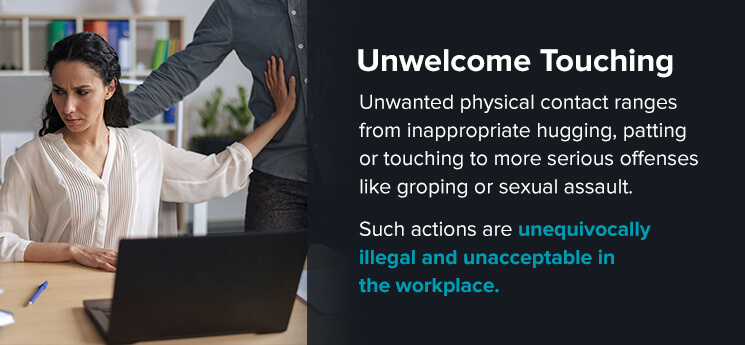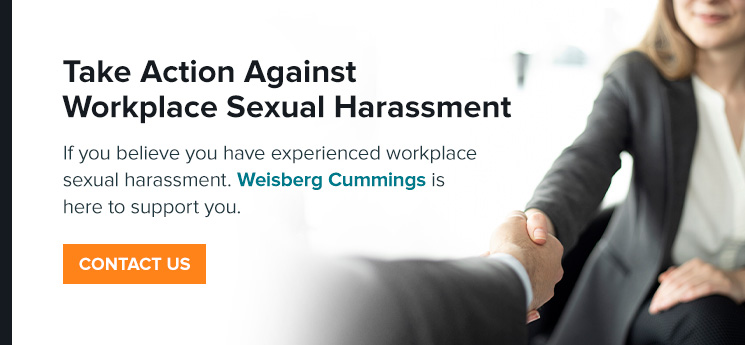By Weisberg Cummings, P.C. on October 26th, 2023
In the modern workplace, sexual harassment charges have remained steady for more than a decade. Sexual harassment can happen to anyone, regardless of gender identity or orientation, and can leave those who experienced it unsure of how to proceed. Understanding the signs of sexual harassment at work is a crucial step toward empowerment and change.
This post explains some of the signs of sexual harassment, how to report it at work and how to take legal action if necessary. If you or someone you know has felt sexually assaulted at work or wondered about the signs someone is harassing you, this blog provides some useful guidance.
What Is Considered Sexual Harassment at Work?
Sexual harassment in the workplace comprises many behaviors and actions, not just physical acts. According to the Equal Employment Opportunity Commission (EEOC), sexual harassment at work refers to any unwelcome sexual advances, comments or actions that create a hostile, intimidating or offensive work environment. This definition includes everything from inappropriate jokes and offensive remarks about someone’s gender to explicit messages and sexual assault. Even if these actions are not physical, they can still constitute sexual harassment if they make someone uncomfortable based on gender or gender identity.
Sexual harassment can come from your boss, co-workers, clients and vendors. Additionally, it doesn’t matter if these people claim they didn’t intend to harass anyone — behavior that creates an unwelcoming or unsafe workplace is harassment.
Sexual harassment is unlawful and can have severe consequences. Employees have rights and protections against it, including the right to seek redress if they believe they have been subjected to harassment. If you have ever asked yourself, “Was I sexually harassed?” or if you think you experienced inappropriate conduct in the workplace, you need to understand your rights and take appropriate action to address it.
Different Forms of Sexual Harassment in the Workplace
Sexual harassment at work can manifest in various ways, creating a distressing and uncomfortable atmosphere. Understanding the distinct forms of workplace sexual harassment is vital. Here are some key types:
- Quid pro quo harassment: This occurs when someone in a position of power makes employment benefits contingent on sexual acts, such as demanding sexual favors for a pay raise or promotion, and then taking adverse employment action if those demands are not met.
- Hostile work environment: In this form, severe and/or pervasive sexually oriented conduct creates an intimidating, hostile or offensive work atmosphere. It can involve explicit jokes, lewd comments or the display of explicit material.
- Verbal harassment: Sexual harassment includes inappropriate comments or questions about personal matters, gender or sexual orientation. Examples include offensive jokes or remarks about an individual’s appearance.
- Unwanted physical contact: This form involves unwelcome physical advances like hugging, touching or kissing. Unwanted sexual touching, even once, may be considered a severe form of harassment.
- Inappropriate conduct based on gender identity or sexual orientation: Harassment can target individuals based on their sexual orientation or gender identity, including humiliating or derogatory remarks.
Recognizing these forms of harassment is essential to addressing and preventing such behavior in the workplace, ensuring a safe and respectful environment for all employees and preventing incidents of sexual harassment at work.
10 Signs of Sexual Harassment in the Workplace
Understanding the signs of sexual harassment is essential to creating a safe and respectful work environment. Here are 10 sexual harassment signs, with real-life examples:
1. Coercion
Coercion is a blatant sign of sexual harassment, where a person in a position of authority or power demands sexual favors in return for job-related benefits. For instance, a supervisor might suggest that a subordinate should engage in sexual acts to receive a promotion or job security. This creates a deeply uncomfortable and exploitative situation for an individual, who may feel trapped and fearful of the consequences of refusing.
2. Discomfort or Fear
Sexual harassment is not always overt — it can involve subtle behaviors that create discomfort or fear. This includes lewd jokes, comments or even explicit conversations that make employees feel uneasy or threatened. A hostile work environment may arise when these behaviors persist, causing anxiety and distress among employees.
3. Unwanted Sexual Attention
Unwanted sexual attention encompasses comments about a person’s appearance, body or clothing. For example, repeatedly commenting on a colleague’s physical attributes or making inappropriate compliments may make them feel objectified and humiliated.
4. Unwelcome Touching
Unwanted physical contact ranges from inappropriate hugging, patting or touching to more serious offenses like groping or sexual assault. The individuals experiencing this may feel violated, unsafe and maybe even traumatized. Such actions are unacceptable in the workplace and are often severe enough in nature to violate the law.
5. Inappropriate Jokes
Jokes of a sexual nature — whether verbal, written or in the form of practical jokes — may be a form of harassment. This includes leaving sexualized items on a co-worker’s desk or making jokes that demean or objectify people based on their sex or gender identity. Such actions create a hostile atmosphere.
6. Sexualized Conversations or Lewd Communications
Engaging in explicit discussions about one’s sex life, sexual acts or sharing pornography at work crosses professional boundaries. Even if these conversations do not directly involve every employee, they contribute to an uncomfortable work environment and should not be tolerated.
7. Repeated Requests for Dates
A colleague or supervisor persistently asking another employee for dates — even after repeated rejections — is a clear form of harassment. This places the individual in an unfair and stressful position, feeling pressured to navigate constant advances.
8. Sexual Gestures
Making sexual gestures or using body language to suggest sexual acts is highly inappropriate and offensive. It communicates a lack of respect for boundaries and creates an uncomfortable and intimidating atmosphere for others.
9. Displaying Pornography
Displaying sexually explicit materials — whether in physical or digital form — is a sign of sexual harassment. For example, a co-worker who keeps a sexually explicit calendar on their desk may be a form of harassment. It can objectify individuals and create a hostile environment that can be deeply distressing for co-workers.
10. Insults
Sexually charged insults, slurs or derogatory language aimed at an individual based on their sex or gender identity may be considered harassment. These insults are often intended to humiliate and intimidate, creating a hostile work environment.
If you’ve been sexually assaulted at work or suspect someone is harassing you, understanding these signs empowers you to address the issue promptly.
How to Report Sexual Harassment at Work
Promptly reporting sexual harassment is crucial to ending the abuse and ensuring a safe workplace. If you have experienced sexual harassment, follow these steps:
- Document everything: Record incidents, including dates, times, locations, individuals involved and details of what transpired.
- Talk to someone: Reach out to a trusted colleague, friend or family member about your experience. Their support can be invaluable.
- Follow company policies: Consult your company’s sexual harassment policy to understand the reporting procedure. You typically contact human resources (HR) or a designated authority.
- File a complaint: Report the harassment to the EEOC, providing documented evidence.
- Legal protection: You are legally protected against retaliation for reporting harassment. Your employer is prohibited from punish you for speaking up about inappropriate sexual behavior.
Reporting harassment is critical to creating a workplace free from such misconduct. Don’t hesitate to act if you have been sexually harassed at work.
Legal Action — Suing Your Employer for Sexual Harassment
If you believe you have experienced sexual harassment at work, you may be able to pursue legal action against your employer. Consult an attorney when:
- Harassment persists: Legal action may be necessary when reporting doesn’t resolve the issue.
- Severe harassment: If you’ve been sexually assaulted at work or subjected to severe harassment, legal recourse is often appropriate.
- Repeated complaints ignored: When your employer fails to address your concerns after multiple reports, it’s time to seek legal guidance.
Legal action may result in compensation for damages and a safer workplace. Consulting an attorney experienced in sexual harassment cases is crucial to understanding your rights and options.
Take Action Against Workplace Sexual Harassment With Weisberg Cummings
If you believe you have experienced workplace sexual harassment, it’s crucial to take action. Weisberg Cummings is here to support you. Our experienced team of attorneys is well-versed in employment law, including sexual harassment cases.
If you’re witnessing the signs of sexual harassment in your workplace or you experienced it yourself, reach out to us today. We’ll provide a free, confidential consultation to discuss your legal options. You have the right to a safe and respectful workplace. Together, we can work towards a future free from harassment.
Contact us online or reach out to us at (855) 716-2367.


